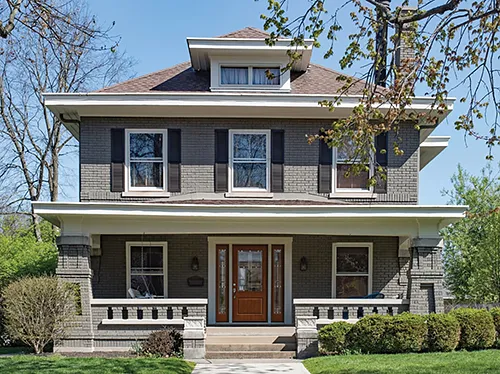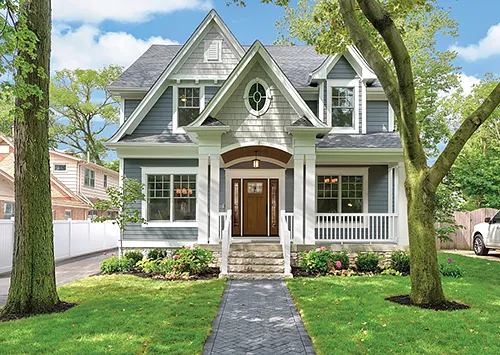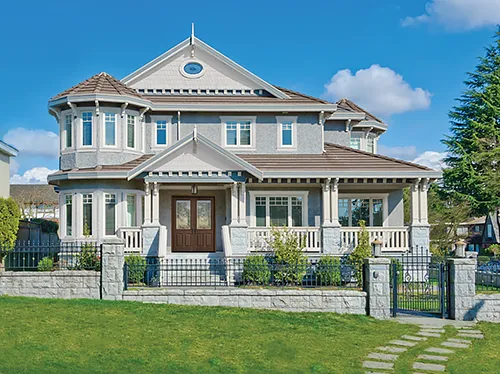Choosing a Fitting Door for Your Historical Home
by Rachel Lyon, Editorial Director for The House Designers
Far from old-fashioned or out of date, homes with historical style are coveted by many. They offer unique appeal owing to their origins—the region where and time period when their architecture was developed. If you have traditional tastes and find yourself renovating a historical home or building new construction with older, classic style, finishing it authentically will bring out its personality best. Start with the front entrance—it’s a natural focal point and helps set the tone for the whole house!
With a simple, predictable shape from top to bottom, an American Foursquare home needs a unique entry to set itself apart. A Classic Craft
® Artissa Collection™ in Mahogany Grain (
Style No. CCR9918) door with a warm finish and
Homeward™ glass definitely does the job.
Research Your Style
The ideal front entry for a classical home won’t be the same as for a Craftsman, so take a look at some famous examples of your architectural style. The doors probably have some things in common, whether it be as basic as their shape or as nuanced as their decorative elements. It may be impossible to perfectly replicate some aspects—like an original glass pattern or the look of a niche wood species—but you’ll find tons of suitable options in today’s market. Factory finishes can deliver a range of authentic woodgrain tones and crisp paint colors, and there’s a great variety of glass types from simple to complex and geometric to ornate and flowery—everything you need to outfit just about any historical home beautifully.
This fancy Cape Cod-inspired cottage features a Shaker-style Fiber-Classic
® Mahogany Collection™ (
Style No. FCM6240) door flanked by sidelites. Transitional
Saratoga™ glass gives this entry an updated rustic feel and a brighter foyer.
Plan for the Whole Entry
The front door contributes to curb appeal, of course, but don’t forget to consider the view from inside as well. Many historical homes included lites and/or transoms to naturally brighten the foyer and make it more welcoming without the need for candles or lamps. So, unless your architecture is defined by solid doors, it’s a good idea to look into glass. It can be included in the door itself for tight entries, and you can branch out to the sides and overhead for grand foyers. In any case, the right decorative glass will also underscore the history of the house and the vibe you want to set!
Even the plainest homes can stand out with a bold door. This understated Smooth-Star
® (
Style No. S1100) entry has a single recessed panel design and a bright Ruby Red PrismaGuard paint finish that grabs attention.
Consider Color
Many people assume that wood was the way to go in the past, but depending on the area, a natural wood front door might be unthinkable. Why? Because a good layer of paint would help protect the door from the elements in harsher climates! This is why you’re more likely to see painted doors in the Northeast than the Southwest. Beyond the practical benefits, paint also came to communicate different things—certain door colors conveyed that a house was welcoming to travelers, had its mortgage paid off, etc. Families used color to make a statement with their homes, and having a variety of door colors on the street made it easier to give directions. These days, woodgrain doors can be as durable as painted ones and the language of color has fallen by the wayside, but colorful front doors are still popular for historical homes given their background.
Such a grand design with a wide façade needs a broad entry for balance. Classic Craft
® Founders Collection™ in Mahogany Grain (
Style No. CCR804029) doors with
Arcadia™ glass beautifully complement the finer design features of this Victorian home.
Fill Breadth with Breadth
Homes have come in all shapes and sizes throughout history, so it stands to reason that doorways should as well. A single door might do for a smaller house or a tighter façade, but you’ll want a double door arrangement and/or sidelites to expand the width of the entryway to match a broader home. Symmetry is a hallmark of many traditional styles, but even asymmetrical houses have always put a focus on visual balance. So, make sure to invest in a door in proportion with the rest of the frontage—it’s such a simple thing, but it makes a huge difference.
No matter what kind of front door you need to complete your historical home, Therma-Tru® has wonderful options for your consideration. The Classic Craft® Founders Collection™ is a great place to start because it is curated to cater to traditional styles. You’ll find a number of woodgrain and paintable door designs and decorative and privacy glass options here. Of course, these aren’t the only possibilities. Feel free to explore all of Therma-Tru’s® collections to find the right fit and use their Design Your Door tool to easily build the best entry for any house, step by step!



.png)
.png)





